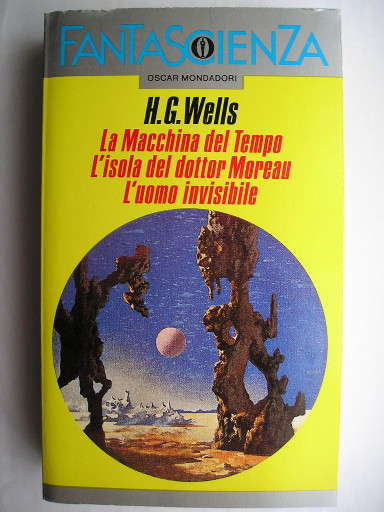
The novel “The Time Machine” by H.G. Wells was published for the first time in 1895. It’s freely available on Project Gutenberg’s website.
The Time Traveller tells his friends that he has built a machine that can travel in time as if it were a space-like dimension. He’s not believed but a few days later he arrives to a dinner at his home with very messy clothes, various wounds and looking very upset.
His friends ask the Time Traveller what happened to him and he starts telling the story of his journey in the year 802,701, made thanks to the machine he invented. At that time so far in the future he met little human beings called the Eloi, who spend their time playing, but also the Morlock, ape-like creatures who live in the underground.
“The Time Machine” was H.G. Wells’ first novel after publishing short fiction and was the work that gave him the great success as a writer. Its fame contributed to spreading the literary genre that at the time was known as scientific romance and after a few decades was called science fiction.
The author had already written a story about time travel, “The Chronic Argonauts”, published in 1888, and thanks to it Wells was asked after a few years to write another story about that subject. That was how “The Machine of Time” was published, told as the account of a journey in time by the protagonist.
In the novel, very few characters have a name and the protagonist is identified only as the Time Traveller but the characters are functional to the plot so they’re not really developed. The protagonist’s meetings with a group of friends make a frame narrative in which he tells about having built a time machine and especially his journey in the year 802.701.
H.G. Wells offers some scientific concepts about time as a space-like dimension but he wasn’t interested in describing the technology used to travel in time, he wanted to talk about the society the Traveller found in the far future. This doesn’t mean that the author neglected the is work’s scientific component, on the contrary the protagonist’s approach in examining what he finds in the future is that of a modern scientist.
When he arrives in the year 802.701, the Traveller meets the Eloi and in particular Weena, a young woman. He tries to figure out what kind of society exists at that time and formulate a hypothesis based on the first data he collected. Spending more time with the Eloi he discovers the existence of the Morlock, whose existence forces him to heavily revisit his hypotheses about the future society.
Eventually, the vision of a future emerges where two separate populations remained that descend from Victorian society’s social classes. Over the course of the millennia there seems to have been an involution because humans seem to have lost many mental faculties. The Eloi, descendants of the ruling class, have also lost their physical strength and live a purely hedonistic life. The Morlock, descendants of the working class, are reduced to fierce creatures.
During the novel, the Time Traveller analyzes the extreme ways in which the social classes have changed and the perverse relationships that established between them. Dystopia was a literary genre already existing and H.G. Wells used it along with time travel to describe a possible projection in the far future of the social divisions of his time.
“The Time Machine” has been adapted many times in different media, also originating other stories more or less inspired by this novel. It’s become one of the first great science fiction classics and had a strong influence on generations of readers and writers. After more than a century, it still remains a point of reference and therefore a must-read for anyone interested in this genre.


Permalink